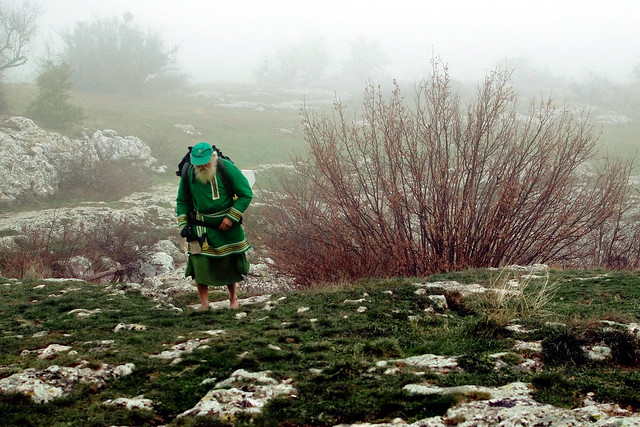Marginalized Population: The Aged and Disabled in Ukraine

The elderly population is the fastest growing age group worldwide, and two-thirds of its population lives in low-income and middle-income countries. Such geographic locations have greater likelihoods of humanitarian crises, and the impacts of humanitarian disasters in these countries are more severe. Research shows the aged and disabled in Ukraine also have higher rates of poverty than younger, non-disabled people, making them more vulnerable during disasters. More than one-fifth of Ukraine’s population (more than 9.5 million people) were over the age of 60 in 2018. The country also is facing one of the world’s most acute global crises today.
Increased Vulnerability and Disproportionate Effects
According to HelpAge International (HAI), marginalization is having greater effects on older individuals, especially older women and the disabled. Since 2014, older persons have constituted more than one-third of the conflict-affected population — equivalent to more than one million people. Many of them have fled their homes due to violence along the contact line — a line dividing government-controlled areas (GCA) from non-government-controlled areas (NGCA). The number of affected people continues to rise as the ceaseless fighting impacts the mental health of the aged and disabled in Ukraine. These populations must contend with widespread landmines and restricted access to nutrition, healthcare, housing, pensions, fuel and public transportation.
Residents living along either side of the contact line and in NGCA are among the most vulnerable in Ukraine because humanitarian access is severely restricted in these areas.
The majority of individuals residing in and displaced from NGCA collect pensions. However, they can claim their pensions only if they are registered as internally displaced persons (IDPs) in GCA. They must also undergo complex and discriminatory vetting for pension verification, including home visits, physical identification in banks and additional safeguards. This approach is riddled with liabilities and creates serious humanitarian consequences because pensions are the sole source of income for most pensioners in NGCA. If approved, administrative requirements demand the aged and disabled travel through five checkpoints along the contact line every few months to avoid pension suspension. These individuals spend 50 to 80 percent of their monthly pension on travel expenses. Consequently, many seniors are cut off from their pensions because they either are physically unable to travel to GCA or cannot afford the trip.
Pensions are not the only reason seniors cross the contact line. They also cross to visit with family, obtain documentation and access medical services. The many restrictions imposed on crossing result in older and disabled persons waiting at entry and exit checkpoints for extended periods of time without adequate facilities like toilets, drinking water or shelter. Red tape often prohibits them from crossing with necessary items like medications and food as these may not be permitted goods. People also must renew their electronic passes on regular basis if they plan to cross — a near impossibility for much of the senior population who has no computer or internet access. These conditions are detrimental to the well-being of the aged and disabled, creating a dire need for mental health services, psychosocial support and life-saving aid.
Forgotten in the Midst of Crises
Marginalizing the older and disabled during disasters is not unique to Ukraine. In 2015, HAI interviewed hundreds of seniors across Ukraine, Lebanon and South Sudan. In all three countries, there was evidence of neglect. Most interviewees said they had never met with anyone to discuss their needs nor did they have sufficient information about available assistance. Almost 50 percent complained that health services were not equipped to treat their age-related conditions, and nearly half said they suffered from anxiety or depression.
Humanitarian Relief for the Aged and Disabled in Ukraine
HAI has worked with the elderly in Ukraine for more than 10 years and has provided them with community safe spaces. The organization has also directed advocacy and coordination efforts with NGOs and UN agencies to ensure that seniors are not excluded from receiving services and psychosocial support. HAI has established support groups and provided home-based care activities, assistive devices and hygiene kits to those of advanced age. However, despite the organization’s humanitarian assistance, a survey they conducted in 2018 showed that those aged 60 and older are still suffering.
The findings were echoed at a 2018 conference organized by the European Commission and the UN Office for the Coordination of Humanitarian Affairs in Brussels. The conference highlighted the support that the WHO and partners have given Ukraine to help combat the devastating effects of the country’s ongoing crisis. During the conference, it also was noted that despite the efforts of the WHO and its health partners, Ukrainian health needs still are on the rise. Speakers attributed the lack of improvement to a weak health system, limited disease prevention and insufficient treatment for chronic illnesses.
The conference also confirmed that the European Union (EU) will provide an additional €24 million to conflict-affected persons in eastern Ukraine, bringing their aid total for Ukraine to more than €677 million. The money will be used to fulfill the essential needs of the most vulnerable populations along the contact line, including IDPs and those in NGCA.
With coordinated efforts and increased humanitarian funding, permanent change for Ukraine is on the horizon.
– Julianne Russo
Photo: Pixabay
